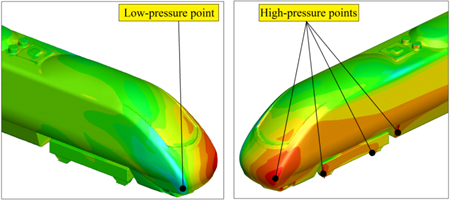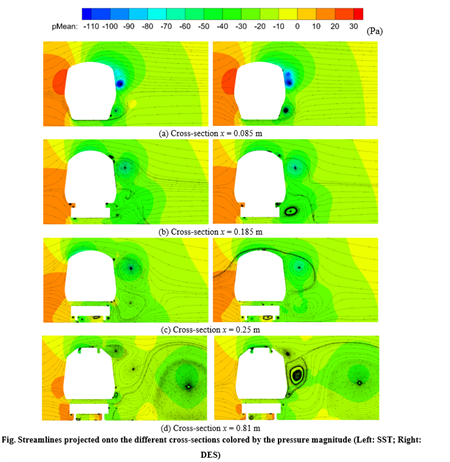The overall aim of this research project is to provide and improve understanding of the flow around train bodies and their reactions to cross winds.
Introduction
A European-wide move to standardize the criteria for certification of railway vehicles has led to the development of regulations for rail operators regarding velocities, pressures and aerodynamic forces generated by trains and on trains in cross winds. There are two approved methodologies currently used in these regulations; physical modelling, which make use of wind tunnel experiments and numerical modelling. The latter involve different computational fluid dynamics (CFD) techniques. Although there are different types of CFD techniques available, all of them suffer the lack of accuracy in predicting the values of the experimental lift force resulting on either overestimation or underestimation of the rolling moment coefficient.
The aim of this innovative Fellowship is to develop an accurate numerical technique based on the steady Reynolds Average Navier Stocks (RANS) capable of accurately predicting the aerodynamic forces. The methodology will be based on wind tunnel experiments, moving model testing and different types of steady and unsteady CFD techniques. In addition, the effect of surface roughness on the lift force prediction of a train subjected to cross wind will be investigated.
Background
Modern train development aims to improve passenger comfort and safety and reduce costs by reducing travel time and producing more efficient engines. This combination leads to an increase of aerodynamic forces on the train and thus increases the danger of rolling over under heavy cross winds. Current methods of modelling using physical (wind tunnels) and numerical modelling (CFD) suffer challenges in predicting lift forces due to challenging and complex structures on the roof and bottom of the train. In a recent RSSB project it was found there are significant variations in aerodynamic results from wind tunnel testing as part of AeroTRAIN project and historical Great Britain data. To accurately predict the lift forces, a full scale experiment may provide robust and reliable results.
However, this is not a viable solution for predicting lift force for the complications associated with this method. In addition, both physical modelling methods and CFD simulations have their own issues and limitations in predicting lift force for trains. However, both methods provide a scope of complimenting each other to aid proper flow visualisation. Therefore, LiftTrain will help address accuracy and reliability concerns through an innovative process.
Funding: This project has received funding from the European Union’s Horizon 2020 research and innovation programmer under the Marie Sklodowska-Curie grant agreement No. 701693
Aim & Objectives
The overall aim of this research project is to provide and improve understanding of the flow around train bodies and their reactions to cross winds. The objectives of this research are as follows:
- Carrying out wind tunnel tests on idealised, smoothed roof train model and a rough train model and repeat the tests on a moving model to measure surface pressures and velocity field. The tests will be carried out at 30 degrees yaw angle.
- To use the results from wind tunnel experiments to develop CFD models based on LES and DES of the flow around roof and the ground for the different train models.
- To develop CFD models based on different RANS models with and without wall functions.
- To develop high RANS model based on wall function capable of accurately estimating lift force.
Impact of the research on European society
This research will give confidence to both train manufacturer and operators on the method used in assessing the stability of trains in cross winds. This should also help engineers in designing the underbody complexities and the roof shape of the new generation of high speed trains in a way to reduce their environmental and structural impact.
Results
Figure 1 shows the setup of the wind tunnel experiment of the smoothed train. Figure 2 shows the surface pressure on the nose of the train subjected to crosswind with 30 degree yaw angle.

Figure 1. Wind tunnel experiment setup of the Class390 Pendolino train.

Figure 2. Surface pressure from the CFD simulation of the Pendolino train subjected to 30 degree crosswinds.
Figure 3 and figure 4 show the velocity distribution around the train at different cross sections.

Figure 3. Streamlines projected on plans at different cross sections.

Figure 4. Streamlines projected onto different cross section coloured by pressure magnitude
(Left: SST model; right: DES results).
The full results of this project can be found in the various publication of the project in the below section.
Publications
- Rashidi M., Hashmi S. A., Soper D., Hemida H. (2019) “On the effect of surface roughness on aerodynamic forces of a high-speed train subjected to crosswinds” (submitted for journal publication in 2019).
- Li, T., Hemida, H., Zhang, J., Rashidi, M. & Flynn, D. (2018) “Comparisons of shear stress transport and detached eddy simulations of the flow around trains” In : Journal of Fluids Engineering, Transactions of the ASME. 140, 11, 12 p., 111108
- Rashidi M. (2017) “Summary of the assessment methods for train stability in crosswinds”. Internal report, University of Birmingham.
- Rashidi M., Hemida H., Krajnovic S., Li T. (2018) “On RANS Simulations for Train Aerodynamics under Crosswinds” (under development).
- Rashidi M., Hemida H. (2018) “Numerical Simulation of the Flow around a Train model with Uniform and Non-uniform Crosswinds” In the proceeding of the International conference in numerical and experimental aerodynamics of road vehicles and trains, Italy.
- Rashidi M., Hemida H. (2018) “Numerical Simulation of the Flow around a High-Speed Train Subjected to Non-uniform Crosswinds” In the proceeding of the Fourth International Conference on Railway Technology: Research, Development and Maintenance, Spain.
- Li T., Zhang J., Hemida H. (2019) “Evaluation of SA-DES and SST-DES models for aerodynamic behaviour of train subjected to crosswind using OpenFOAM” (submitted for journal publication 2019).
Contact
Dr Hassan Hemida
School of Engineering, University of Birmingham
Tel: 0121 414 4215
Email: h.hemida@bham.ac.uk